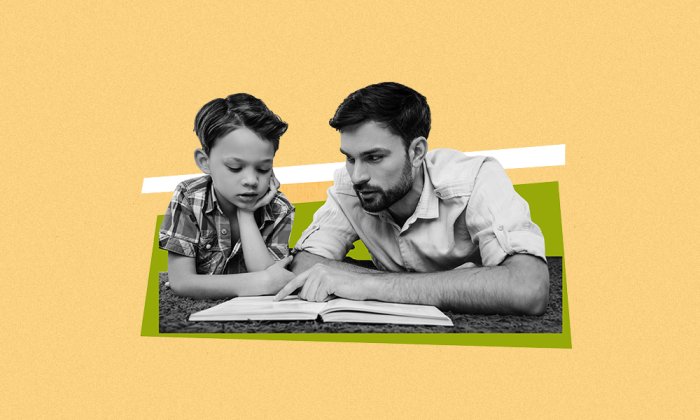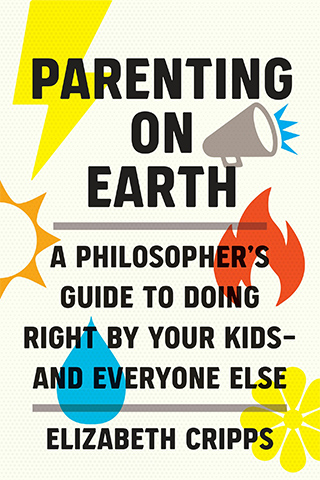Being Good Parents Means Having Hard Conversations

When my daughters were babies, I dressed them in hand-me-downs from my nephews, much to the consternation of older ladies on buses. One exclaimed in confusion at a pink hat and blue coat combination, unable to guess the baby’s sex. “But she’s wearing blue!” another one protested, when I said my child was a girl. She could hardly have sounded more accusing if I’d been in the dock for fraud.
The incidents were minor enough. But the point they illustrate isn’t. There’s no such thing as neutrality in the world our children are growing up in. They will acquire values from somewhere, and if they don’t get them from us, they’ll pick them up elsewhere.

Children, says anti-racism educator Jennifer Harvey, inhale racism “like smog in the air.” According to behavioral scientist Pragya Agarwal, they have well-formed attitudes by about six. By nine, highly stereotyped views can be hard to root out. In a racist society (and our societies are still fundamentally racist), not teaching them to be anti-racist is, in effect, leaving them to become the reverse. If we don’t raise our kids to be feminists, they will learn their own lessons from the myriad incidents of sexism or misogyny that they see around them.
Kids are also exposed early to consumerism. With almost every interaction, they learn to value a collectively disastrous way of life. I didn’t want my daughters to be materialistic; I certainly didn’t set out to make them so. But it didn’t take them long to demand shiny plastic toys in the likeness of their favorite cartoon characters, or the same gadgets as their friends. Consumer psychologist Cathrine Jansson-Boyd tells me that teenagers learn quickly to label people, in terms of what they can and cannot afford. “Parents,” says Fowler, “need to decide what values children will be socialized into endorsing.”
There’s no such thing as neutrality in the world our children are growing up in.
There’s something else I should remember, too. The secure childhood I enjoyed, and yearn to reproduce for my own kids, was also a sign of my own privilege.
“Black children don’t get to not understand racism.” That’s what comedian Tawny Newsome tweeted, nine days after George Floyd’s murder. In 2014, 12-year-old Tamir Rice was shot by Cleveland police because he was playing with a replica gun. Writer Sai’iyda Shabazz won’t even let her six-year-old son play with a water pistol in public. In 2020, a YoungMinds blogger, Luke, aged 15, wrote: “I felt so depressed and almost worthless in myself because of my skin color.” He was the victim of racist bullying.
“It’s deeply necessary,” says Harvey, “that we let our children’s hearts get broken a bit if they are going to remain able to recognize the humanity of their fellow humans whose lives are at stake in the system we live in.” White parents, she says, teach white kids that police officers are safe. They tell to go to them if they are lost. Black parents can’t do that. When political theorist Alice Baderin coined the term “anticipatory parenting,” it was to describe what Black parents must already do, day by day: trying to spare their child racist experiences (for example, by constant vigilance or making sure they aren’t the only child of color in a group); trying to mitigate the mental and physical harm of the incidents that are, despite this, inevitable.
Harvey tells another anecdote: her daughter being told by a boy at school that he could cut ahead of her in line because “boys go first.” Her child, she says, “was having an experience of sexism whether I decided to support her in interpreting it or not.” Our daughters will learn soon enough that this is a man’s world, even if we don’t tell them. They will learn it from incidents like those. From reading “Boys” (in blue) on the boxes of engineering toys and “Girls” (in pink) on the ones with florists or hairdressers. From clothes that sexualize 12-year-old girls or turn teenage boys into pretend soldiers. From seeing powerful male politicians get away with harassment. They will learn to expect groping on public transport, or sexual harassment in the playground. “If I had a penny for every sexist thing I’ve heard kids say,” says Melinda Wenner Moyer, in her brilliantly titled book “How to Raise Kids Who Aren’t Assholes,” “I would be lounging on a beach in Bermuda rather than writing this book.”
In 2019, UK psychologists warned: “For children growing up in a landscape of ever-increasing danger and parental stress, we risk developmental trauma becoming a ‘normal’ part of childhood experience.” In 2019, 57 percent of teenagers in the United States were afraid of climate change. More than half were angry. And that was before the pandemic. In 2020, a UK children’s news program interviewed 2,000 eight- to 16-year-olds. Almost three quarters were worried about the state of the planet and 22 percent were “very worried.” Seventeen percent struggled with eating or sleeping because of it, and four out of 10 didn’t trust adults to tackle the problem. In 2022, a 17-year-old Australian activist, Anjali Sharma, published an article in a major newspaper: “Dear politicians, young climate activists are not abuse victims, we are children who read news.”
In the face of this, silence isn’t “being kind.” It’s dangerous. Susan Clayton, psychology professor and fellow of the American Psychological Association, puts it starkly enough: “If you try not to talk to your child, they will still know it’s a problem. They will just think this isn’t something parents can help with. It will erode their feelings of confidence in their parents.”
So, yes, it breaks my heart to talk to my girls of floods and wildfires, Russian military tanks and families fleeing their homes, gun deaths, and hospitals that cannot keep their patients safe. I hate to see fear in the faces that I want to see laughing. And, yes, this is an additional wrong that we’re doing our kids, requiring them to respond to the mess that past generations have created. But pretending that it isn’t happening? That’s a betrayal too. Harvey is right: this is needed, to prepare our kids for the world they are growing up in.
Like most of parenting, this isn’t an all-or-nothing choice: Tell the whole truth now or keep our children’s childhoods idyllic. There’s a fine line to tread between preparing our kids for the future they will actually face and not piling more harsh reality onto them than they can cope with; between building them up into good global citizens and keeping the joy of those early years, as far as we can.
So how do we go about it?
Walking the Line
Point one. Being good parents means having hard conversations — and making our children part of the way forward.
After years of happily wearing whatever color came to hand, my older daughter returned from school one day and told me blue was a “boy’s color.” I told her there was no such thing. I reminded her of the boys we know who love pink, of how often I wear blue. Researching for “Parenting on Earth,” a few years later, I realized I should have done something else. I should have warned her how often she would meet that kind of prejudice. When Harvey’s daughter first talked about the boy pushing ahead at school, Harvey avoided using the language of “sexism.” But later, with her daughter still struggling to process what had happened, she gave it a label. She warned her to expect many such incidences and told her that in standing up for herself, she had stood up for other girls. White parents, says Harvey, should have a version of “the talk,” preparing their children for what their contemporaries of color will face, and building them up to be allies.
But in presenting these unpalatable truths, it’s essential to distinguish between individual and collective responsibility. Harvey’s daughter, confused by another incident at school, asked her, “Am I racist?” But it’s the system we live in that’s racist. If your children are privileged — and mine are, I know — they must learn to understand that, without hating themselves for it.
If our children are scared, then getting involved, from raising money for refugees to marching outside government buildings, is one way for them to regain a sense of control.
Early in the Russia-Ukraine war, Pragya Agarwal shared her advice on talking to kids about the situation. “Be honest, explain and don’t brush away their questions, stay calm, try not to show fear & anxiety, listen actively and think about positive things we can do together” (italics added). Because if our children are scared (and they often are), then getting involved, from raising money for refugees to marching outside government buildings, is one way for them to regain a sense of control. In encouraging this, says Susan Clayton, you simultaneously do something positive, and boost your children’s mental health.
When my older girl was five, she announced that she and her friend were going to make a machine to take all the plastic out of the ocean when they grew up. She was excited. It wasn’t a burden, at that age. It was an opportunity. For months after their first climate marches, both my girls would burst into a spontaneous chant: “What do we want? CLIMATE JUSTICE! When do we want it? NOW.” They did it at disconcerting moments: on a bus, in the post office, halfway down a busy street. But I was glad they did.
Point two. To quote educator Harriet Shugarman, we must “make time to read, share stories, and be together in nature.”
Herbert Murungi combines all three. He tells me how his parents sat round the fireplace with him, telling fairy tales. Now his own children’s stories are distributed to schools, and he fundraises to plant trees with the kids that read them. In Cape Town, Xoli Fuyani “didn’t want to go in and lecture, we wanted to create something fun and experimental.” She ended up with worm farms, and the children loved them. At home, she grows most of her own vegetables, and has her own children learn by helping out. In Vermont, Meredith Niles, an associate professor in food systems, describes her child’s joy in their garden: how the little girl will pick a tomato and bite into it as though it were an apple. Studies confirm what these educators and activists all know: Access to nature encourages kids to behave in an environmentally friendly way.
Equally, it takes more than a generic “Girls can do that!” to counter gender stereotypes. “Look at your aunt,” we must say, pointing to a doctor or engineer or scientist. “Look at your friend’s mother or your physician.” Our children need examples of activists of color, says Harvey, and of white people fighting for anti-racism. They need true stories. They need fiction. They need stories featuring children of color that have nothing to do with racism.
I try. I read my girls “Goodnight Stories for Rebel Girls.” I read them the “Unicorn Rescue Society” and “Zoey and Sassafras.” When we read the books I loved unquestioning as a child, I help them call out stereotypes. It’s a start.
Point three. How we do all this matters, too.
In the novel “Hard Times,” schoolmaster Thomas Gradgrind raises his children like he teaches those of others: according to a strict formula. The beauty of flowers counts for nothing, hard statistics are all. He condemns emotion and shows none in his own home. The result, for his children, is disaster. His son becomes a thief; his daughter marries a bully she doesn’t love, contemplates infidelity, and is thoroughly miserable.
The moral of Charles Dickens’s story, now neatly confirmed by developmental psychology, is this. Authoritative parenting — proactive, supportive, sympathetic, using positive reinforcement and honest dialogue, setting limits and clear rules, but not applying them arbitrarily — is better for moral development than a harsh, punitive, or power-assertive authoritarian approach.
“Our children are watching us,” Shugarman tells me, “even if they don’t seem to be listening.” Psychologists Mary Eberly Lewis and Scott Franz studied conversations about volunteering between 52 teenage girls and their mothers. They found the teenagers were less receptive if the conversations were disruptive or antagonistic, if their mothers dominated or tried to control the debate, showed contempt, or devalued the project. A 2015 study found that parents with higher “cognitive empathy” (the ability to take in others’ perspectives) had toddlers who were better at sharing.
As a parent, I can model speaking up. I can model care for others. I can model care for nature. I can help our children learn to take disappointment in stride, and to feel pride in action. I can encourage my daughters to ask questions, ask their opinions, and help them work through difficult ideas for themselves. I can talk climate action over the dinner table, as Shugarman suggests, and really listen to what they have to say. When I take them on climate or anti-racism marches, we can discuss why it matters so much, along the way. These interactions are Socratic, rather than laying down the law. They also forward my daughters’ growing autonomy.
I can be there for them. “Not feeling alone is probably the most important prescription for long-term resilience,” says environmental studies professor Sarah Jacquette Ray. If our children are to cope with what the world will (and we must) teach them, they will need to learn how to manage, not deny, the emotions that these ongoing crises throw at them. This will not be easy. They need love and compassion, empathy, and availability. They need to learn to develop friendships. My daughters need to know, now and in the future, that they have “adult allies” and that I am one of them.
The key to all this? Different approaches, for different ages.
In the early years, climate education is about enabling kids to experience the wonder of nature, about love and hugs (“if,” as Shugarman puts it, “that’s your thing”). Kids might also be taught to respect shared resources, whether it’s things at home that belong to the whole family, or equipment at the playground in the park. Encouraging empathy means helping preschoolers express emotions, and reflect on those of others. It means asking, “How do you think that made her feel?” Anti-racist and anti-sexist education begins with openness about difference, teaching children that they are in control of their own bodies, modeling consent.
Then there are the elementary school years, when we can point out examples in books or TV that go against stereotypes (a cartoon Dad staying at home with his kids, a Black woman scientist), or supplement the often-limited version of history taught in schools. We can label feelings, challenge disrespectful language, and encourage our kids to do the same. We can take them with us on protests or give them simple jobs, like putting bottles in the recycling, or turning off lights. “So,” says Clayton, “they feel engaged in the struggle.”
As kids grow, we can share simplified science. We can talk about treasured outdoor places, why they matter, and how they are threatened. We can give names to key concepts like “consent” or “assault.” We can encourage our kids to be friends, non-romantically, across genders. We can talk justice over dinner, be open about difficult topics like identity and oppression, prompt our children to notice power dynamics. We can encourage them to do school projects on justice or the environment.
As they get older again, kids can learn more complicated science and politics. They can think critically. They can be taught to recognize credible, peer-reviewed research, and critically evaluate their news sources. We can remind them that they, like us, are moral agents. “Help your high schooler understand that the world does not revolve around him,” writes clinical psychologist Bobbi Wegner, on raising feminist boys. We can support our teenagers to become allies and activists, advocates rather than bystanders, and to make regular activities of challenging norms.
The conversations with our children are very different, from ages three to 18. But the imperative is the same.
Elizabeth Cripps is a mother, writer, activist, and philosopher. She is the author of “What Climate Justice Means and Why We Should Care” (Bloomsbury) and “Parenting on Earth,” from which this article is excerpted. She is a Senior Lecturer in Political Theory at the University of Edinburgh, where she researches and teaches climate justice. She lives in Scotland with her husband and two daughters.



